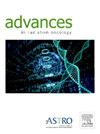立体定向体放射治疗伴直肠移位的明胶泡沫骶骨脊索瘤3例初步报告
IF 2.7
Q3 ONCOLOGY
引用次数: 0
摘要
目的骶脊索瘤的治疗仍然具有挑战性,因为其高复发率、术后并发症和有限的有效放射治疗选择。我们报告了一个小病例系列的骶脊索瘤治疗完全基于光子立体定向放射治疗(SBRT),结合直肠移位通过断层扫描引导下的gel泡沫基溶液的放射介入介入。这种新颖的组合在以前的文献中没有描述过。方法与材料:选取经活检证实的骶骨常规脊索瘤患者。所有患者均行SBRT伴直肠移位,接受单一24 gy剂量。概述了治疗参数和计划细节。结果在2022 - 2024年间,对3例患者进行了分析。2例为treatment-naïve, 1例为复发性疾病。中位年龄为62岁(57-70岁)。中位随访21个月(范围3 ~ 32),局部控制率为100%;除1例患者出现短暂性疼痛外,无与治疗相关的临床显著不良事件(包括胃肠道/直肠毒性)。由于位移,直肠方向的平均剂量梯度为1.4 Gy/mm,导致直肠剂量可能减少约7至14 Gy。结论:这个小的病例系列表明,直肠使用凝胶泡沫溶液的SBRT治疗骶脊索瘤是一种可行且耐受性良好的方法。进一步的前瞻性研究需要更大的队列和更长时间的随访来验证这些发现,并评估长期疗效和安全性。本文章由计算机程序翻译,如有差异,请以英文原文为准。
Stereotactic Body Radiosurgery Associated With Rectal Displacement using Gelfoam for Sacral Chordomas: Preliminary Report of 3 Cases
Purpose
The treatment of sacral chordomas remains challenging because of high recurrence rates, postoperative complications, and limited effective radiation therapy options. We report a small case series of sacral chordoma treated exclusively with photon-based stereotactic body radiation therapy (SBRT), incorporating rectal displacement via tomography-guided radiointerventional interposition of a Gelfoam-based solution. This novel combination has not been previously described in the literature.
Methods and Materials
Patients with biopsy-confirmed sacral conventional chordomas were included. All patients underwent SBRT with rectal displacement, receiving a single 24-Gy fraction. Treatment parameters and planning details are outlined.
Results
Between 2022 and 2024, 3 patients were analyzed. Two were treatment-naïve, whereas 1 had recurrent disease. The median age was 62 years (range, 57-70). After a median follow-up of 21 months (range, 3-32), the local control rate was 100%; there were no treatment-related clinically significant adverse events (including gastrointestinal/rectal toxicities), except for 1 patient who experienced transient pain. The average dose-gradient of 1.4 Gy/mm toward the rectum because of displacement, leading to a potential reduction of the rectal dose by approximately 7 to 14 Gy.
Conclusions
This small case series suggests that SBRT with rectal using a Gelfoam-based solution is a feasible and well-tolerated approach for sacral chordoma treatment. Further prospective studies with larger cohorts and extended follow-up are warranted to validate these findings and assess long-term efficacy and safety.
求助全文
通过发布文献求助,成功后即可免费获取论文全文。
去求助
来源期刊

Advances in Radiation Oncology
Medicine-Radiology, Nuclear Medicine and Imaging
CiteScore
4.60
自引率
4.30%
发文量
208
审稿时长
98 days
期刊介绍:
The purpose of Advances is to provide information for clinicians who use radiation therapy by publishing: Clinical trial reports and reanalyses. Basic science original reports. Manuscripts examining health services research, comparative and cost effectiveness research, and systematic reviews. Case reports documenting unusual problems and solutions. High quality multi and single institutional series, as well as other novel retrospective hypothesis generating series. Timely critical reviews on important topics in radiation oncology, such as side effects. Articles reporting the natural history of disease and patterns of failure, particularly as they relate to treatment volume delineation. Articles on safety and quality in radiation therapy. Essays on clinical experience. Articles on practice transformation in radiation oncology, in particular: Aspects of health policy that may impact the future practice of radiation oncology. How information technology, such as data analytics and systems innovations, will change radiation oncology practice. Articles on imaging as they relate to radiation therapy treatment.
 求助内容:
求助内容: 应助结果提醒方式:
应助结果提醒方式:


